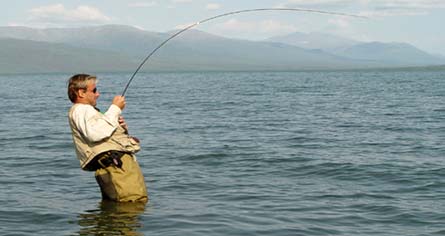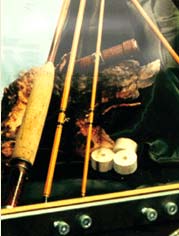Fly Rods
G2, Thomas & Thomas, Hardy, Greys or Redington?


Short or long? Slow or fast action? Line rating #2 or #12? How many sections 2, 4 or 7?
The selection of the correct fly rod is of decisive importance. Did you know that with all makes and in all price segments, around 25% to 75% of the rods are bean poles! Before we engage ourselves with the above questions regarding line rating, rod action I would like to explain the above text. In 1967 I had a sporting accident during the 30 gram distance casting competition. My 0.50mm shock-leader broke under full-load and my right arm, me, along with the tackle, flew several meters into the casting field. The sinews in my elbow were so badly torn that for a very long time I could not even hold a teacup. Thank the expert attention of the tennis elbow specialist Dr Hauser in Winterthur I was able to continue my career as professional caster for a few years after modifying my casting style for all disciplines. Replacing power with optimized and an absolutely effort-free technique means more engagement from the “pulling hand” – in my case the left-hand. Was it this accident that resulted in the “Hebeisen Casting Style” taught over the decades in the Hebeisen Casting School? Almost certainly! The High Speed – High Line from Charles Ritz, the experience and special hand management when competition casting, the input from Hans Gebetsroither with his “under through and above over”, not only coincides with my personal experience but also the fact that the rod hand movement has to be optimized or, in other words, minimized. Why? Quite simple: A short power stroke results in also a narrower loop, which all my instructors cast, this reduces the effort required but, above all, I optimized my left or “pulling” hand. Did you know that a fly rod cast can be accomplished with 80% effort from the “pulling hand” and 20% from the “rod hand”? Is it clear that all long casts, especially the extremely long casts, come from the “pulling hand” and not from the “rod hand”? Otherwise, how could it have been possible that in Lenzerheid, two years after my accident in 1969, I cast an absolute world record of 62.73 metre with a single handed fly rod (nota bene: a hollow glass fibre rod costing only CHF 35.00)? ... certainly not with the rod hand! Normally I do not laugh about such things but in 2007 I had to laugh, and not quietly, when a reputed specialist took-up stance with his right leg out in front of him so that he could get more power into the cast. What can you do when somebody today makes the back-cast up and above or casts with the thumb on top (resulting in a lopsided fly reel) or, expressed mildly, have not understood the elementary principles of fly rod casting. By necessity, such casters have to compensate a faulty casting technique with unnecessary effort. It could be much better and much easier. What has this got to do with the perfect action of a fly rod? To this day my elbow is so sensitive that the slightest imperfection immediately releases a signal. I once classified 24 fly rods among friends into good, medium and bad groups and the rods were duly marked, I retested the rods blindfolded - the grouping results were the same. Enough about my experience otherwise I will be writing a book regarding the correct fly rod selection, now, a clear statement regarding this matter: First and foremost “quality is worth the investment”, my favourite rod for dry fly fishing is still the 7 foot, or 215cm, Orvis HRH-Special loaded with a WF 5 F Long belly line – I am still using the prototype built in 1977! Three rods are sufficient for every type of fly fishing all over the world, if you include tarpon fishing, this could extend to four and maybe five if you include a double-handed rod for fishing large pools in, for example, Norway, Scotland or Ireland – and that’s about it. What ever you do don’t purchase the same four times. It is better to buy one that you will use a lot, which is three times more expensive - in the long run this is cheaper and better. You will effectively require a fly rod rated at #5/6 for dry fly and nymph fishing. If you select a short rod around seven foot or medium length rod around eight foot or even longer around nine foot depends if you are fishing lakes or reservoirs, in rivers or streams and if you are allowed to wade or not. Consequently, a large river and long rod when you are allowed to wade is the incorrect choice just as much when you fish a meadow stream with a short rod because you will be continually caught-up in the grass. Further, a rod with the rating #7/8 will be required. With this rod you can fish the streamer all over the world, cast the dry fly on rivers and reservoirs (in many cases even with a #6 fly line) and fish for salmon (excluding King Salmon) in Ireland, Iceland and Alaska. This “medium” rod should be about nine foot long. The “heavy” rod with a line rating of #9/10 is for larger salmon and is becoming more and more popular when fishing for pike. Line sizes #11/12 are more for salt-water work when fishing especially for tarpon - the rods in this case should not be over nine foot long otherwise they will put too much strain on your wrist when casting. And now to the double handed rod: You can tell me what you want - a nine foot single handed rod casts further and with less effort than a twelve foot double handed fly rod and with a 14 foot or even a 15 foot double handed rod you require 30% less effort than you do with a 13 foot rod. The double handed rod is neither for catching large salmon nor casting long distances and I have written quite a lot about this – for all I care, those who still do not believe me should continue to persevere with a short double handed rod. Up to now we have only dealt with length and line ratings – what about the rod action and number of sections? Quite clear, the international fly fisher who takes his rods on-board an aircraft uses rods with 4 to 7 sections because of the transport problem. For those who can reach their fishing destinations by car are far better off with a 2 section rod. With regard to action I still prefer for the lighter line ratings the classical fast parabolic action (where you feel the rod loading in the casting hand), for the higher line ratings, which require more action, the action can be further forward. What I do not like are fly rods with an extreme tip action where the half, or even more, of the rod is stiff, or when you pick-up a rod (and unfortunately there are lots of rods in the highest price bracket with this fault) where the action starts directly in front of the fly rod handle – for goodness sake, put the thing back in the rod rack! And now a humble question: Is built bamboo acceptable? With the products from G2 we offer you some of the finest hand-built bamboo rods. Only those who have held such a rod and know how much work goes into the making of such a rod can appreciate them and know their value. Fly rods that maintain their value and even increase in price as they get older.
|

